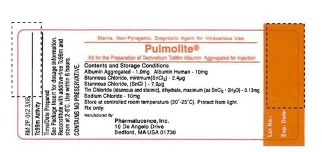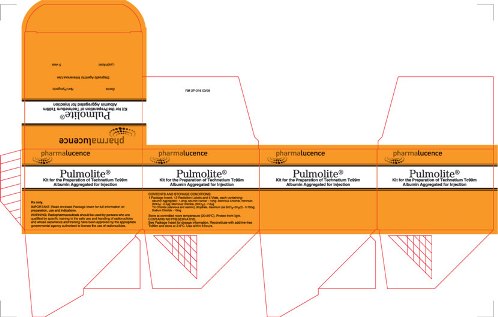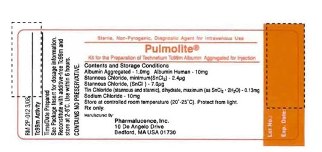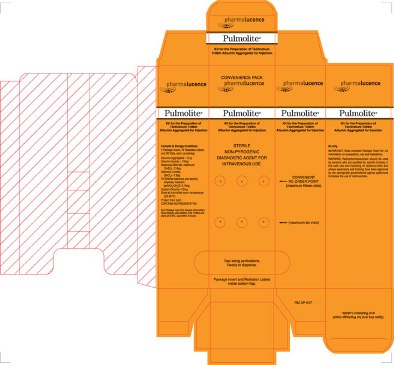PULMOLITE, KIT FOR THE PREPARATION OF TECHNETIUM TC99M ALBUMIN AGGREGATED FOR INJECTION
-
albumin aggregated injection
Pharmalucence, Inc.
Each vial contains a sterile, non-pyrogenic, lyophilized mixture of:
The pH of the kit when reconstituted with 5ml of Sodium Chloride Injection is 5.0-8.0. The contents of the vial are lyophilized and stored under sterile filtered air.
The Albumin Human was non-reactive when tested for hepatitis B surface antigen (HB2Ag). The aggregated particles are formed by denaturation of Albumin Human in a heating and aggregation process. Each vial contains 3.6-6.5 million particles. By light microscopy, more than 90% of the particles are between 10 and 90 micrometers, while the typical average size is 15 to 30 micrometers; none is greater than 150 micrometers.
The drug is administered by intravenous injection for diagnostic use after reconstitution with sterile, non-pyrogenic, oxidant-free Sodium Pertechnetate Tc99m Injection. No less than 90% of the pertechnetate Tc99m added to the vial is bound to the aggregates at preparation time and remains bound throughout the 6 hour lifetime of the preparation.
The precise structure of stannous technetium albumin aggregated complex is unknown at this time.
PHYSICAL CHARACTERISTICS
Technetium Tc99m decays by isomeric transition with a physical half-life of 6.02 hours.1 Photons that are useful for detection and imaging studies are listed in Table 1.
| Radiation | Mean %/Disintegration | Mean Energy (keV) |
| Gamma-2 | 89.07 | 140.5 |
1Kocher, David C., Radioactive Decay Data Tables, DOE/TIC-11026, 108 (1981).
EXTERNAL RADIATION
The specific gamma ray constant for Tc99m is 5.4 microcoulombs/kg-MBq-hr (0.78R/mCi-hr) at 1cm. The first half value layer is 0.017cm of Pb. A range of values for the relative attenuation of the radiation emitted by this radionuclide that results from interposition of various thicknesses of lead (Pb) is shown in Table 2. To facilitate control of the radiation exposure from MBq (mCi) amounts of this radionuclide, the use of a 0.25cm thickness of lead (Pb) will attenuate the radiation by a factor of 1,000.
| Shield Thickness (Pb) cm | Coefficient of Attenuation |
| 0.017 | 0.5 |
| 0.08 | 10-1 |
| 0.16 | 10-2 |
| 0.25 | 10-3 |
| 0.33 | 10-4 |
To correct for physical decay of this radionuclide, the fractions that remain at selected time intervals after the time of calibration are shown in Table 3.
| Hours | Fraction Remaining | Hours | Fraction Remaining |
| 0* | 1.000 | 7 | .447 |
| 1 | .891 | 8 | .398 |
| 2 | .794 | 9 | .355 |
| 3 | .708 | 10 | .316 |
| 4 | .631 | 11 | .282 |
| 5 | .562 | 12 | .251 |
| 6 | .501 |
*Calibration time
Immediately following intravenous injection, more than 80% of the Albumin Aggregated is trapped in the pulmonary alveolar capillary bed. The imaging procedure can thus be started as soon as the injection is complete. Assuming that a sufficient number of radioactive particles has been used, the distribution of radioactive aggregated particles in the normally perfused lung is uniform throughout the vascular bed, and will produce a uniform image. Areas of reduced perfusion will be revealed by a correspondingly decreased accumulation of the radioactive particles, and these areas are imaged as areas of decreased photon density.
Organ selectivity is a direct result of particle size. Below 1-10 micrometers the material is taken up by the reticuloendothelial system. Above 10 micrometers the aggregates become lodged in the lung capillaries by a purely mechanical process. Distribution of particles in the lungs is a function of regional pulmonary blood flow.
Lung to liver ratios greater than 20:1 are obtained in the first few minutes post-injection. Elimination of the Technetium Tc99m Albumin Aggregated from the lungs occurs with a half-life of about 5 hours. Cumulative urinary excretion studies show an average of 20% elimination of the injected Tc99m dose 24 hours post administration.
Following administration of Technetium Tc99m Albumin Aggregated by intraperitoneal injection, the radiopharmaceutical mixes with the peritoneal fluid. Clearance from the peritoneal cavity varies from insignificant, which may occur with complete shunt blockage, to very rapid clearance with subsequent transfer into the systemic circulation when the shunt is patent.
Serial images should be obtained of both the shunt and the lung (target organ). However, an adequate evaluation of the difference between local blockage of the shunt and partial blockage may not be feasible in all cases.
Technetium Tc99m Albumin Aggregated Injection is a lung imaging agent which may be used as an adjunct in the evaluation of pulmonary perfusion in adults and children.
Technetium Tc99m Albumin Aggregated may be used in adults as an imaging agent to aid in the evaluation of peritoneo-venous (LaVeen) shunt patency.
Technetium Tc99m Albumin Aggregated Injection should not be administered to patients with severe pulmonary hypertension.
The use of Technetium Tc99m Albumin Aggregated Injection is contraindicated in persons with a history of hypersensitivity reactions to products containing human serum albumin.
Although adverse reactions specifically attributable to the Technetium Tc99m Albumin Aggregated have not been noted, the literature contains reports of deaths occurring after the administration of Albumin Aggregates to patients with pre-existing severe pulmonary hypertension. Instances of hemodynamic or idiosyncratic reactions to preparations of Technetium Tc99m Albumin Aggregated have been reported.
In patients with right-to-left cardiac shunt, additional risk may exist due to the rapid entry of Albumin Aggregated into the systemic circulation. The safety of this agent in such patients has not been established.
Hypersensitivity reactions are possible whenever protein-containing materials such as pertechnetate labeled Albumin Aggregated are used in man. Epinephrine, antihistamines, and corticosteroids should be kept available for immediate use.
The intravenous administration of any particulate material such as Albumin Aggregated imposes a temporary, small mechanical impediment to blood flow. While this effect is probably physiologically insignificant in most patients, the administration of Albumin Aggregated is possibly hazardous in acute cor pulmonale and other states of severely impaired pulmonary blood flow.
The preparation contains no bacteriostatic preservative. Technetium Tc99m Albumin Aggregated Injection should be used within 6 hours of preparation.
Technetium Tc99m Albumin Aggregated Injection is physically unstable and consequently the particles settle with time. Failure to agitate the vial adequately before use may result in non-uniform distribution of radioactive particles.
Mix the contents of the syringe just before injection. If blood is drawn into the syringe, any unnecessary delay prior to injection may lead to clot formation. Slow injection is recommended.
Do not use if clumping of the contents is observed.
The Technetium Tc99m labeling reactions involved depend on maintaining the stannous ion in the reduced state. Hence, Sodium Pertechnetate Tc99m Injection containing oxidants should not be employed.
Contents of the vial are intended for reconstitution with Technetium Tc99m and are not to be administered directly to the patient.
Radioactive drugs must be handled with care and appropriate safety measures should be used to minimize radiation exposure to clinical personnel. Also, care should be taken to minimize radiation exposure to the patients consistent with proper patient management.
The contents of the kit before preparation are not radioactive. However, after the Sodium Pertechnetate Tc99m Injection is added, adequate shielding of the final preparation must be maintained.
The components of the kit are sterile and non-pyrogenic. It is essential to follow directions carefully and to adhere to strict aseptic procedures during preparation.
Radiopharmaceuticals should be used only by physicians who are qualified by training and experience in the safe use and handling of radionuclides and whose experience and training have been approved by the appropriate government agency authorized to license the use of radionuclides.
No long-term animal studies have been performed to evaluate carcinogenic potential or whether Technetium Tc99m Albumin Aggregated Injection affects fertility in males or females.
Animal reproduction and teratogenicity studies have not been conducted with Technetium Tc99m Albumin Aggregated Injection. It is also not known whether Technetium Tc99m Albumin Aggregated Injection can cause fetal harm when administered to a pregnant woman or can affect reproductive capacity. There have been no studies in pregnant women. Technetium Tc99m Albumin Aggregated Injection should be given to a pregnant woman only if clearly needed.
Ideally, examinations using radiopharmaceuticals, especially those elective in nature, of a woman of childbearing capability, should be performed during the first few (approximately 10) days following the onset of menses.
Technetium Tc99m is excreted in human milk during lactation. Therefore, formula feedings should be substituted for breast feeding.
The lowest reasonable number of particles should be used in pediatric patients with right-to-left cardiac shunt, in neonates and in severe pulmonary disease.
Clinical studies of Pulmolite did not include sufficient numbers of subjects aged 65 and over to determine whether they respond differently from younger subjects. Other reported clinical experience has not identified differences in responses between the elderly and younger patients. In general, dose selection for an elderly patient should be cautious, usually starting at the low end of the dosing range, reflecting the greater frequency of decreased hepatic, renal, or cardiac function, and of concomitant disease or other drug therapy.
The literature contains reports of deaths occurring after the administration of Albumin Aggregates to patients with pre-existing severe pulmonary hypertension. Instances of hemodynamic or idiosyncratic reactions to preparations of Technetium Tc99m Albumin Aggregated have been reported. (See Warnings.)
The recommended intravenous dose range for the average (70kg) ADULT patient is 37MBq to 148MBq (1-4mCi) of Tc99m Albumin Aggregated after reconstitution with oxidant-free Sodium Pertechnetate Tc99m Injection. The recommended number of particles per single injection is 200,000-700,000 with the suggested number being approximately 350,000. Depending on the activity added and volume of the final reconstituted product, the volume of the dose may vary from 0.2 to 1.2ml. See Table 4 for adult dosing information.
The number of particles available per megabecquerel (millicurie) dose of Technetium Tc99m Albumin Aggregated Injection will vary depending on the physical decay of the technetium that has occurred. The number of particles available in any specific dose may be estimated by calculating the number of particles per milliliter at the time of calibration.
In PEDIATRIC patients, the suggested intravenous doses employed for perfusion lung imaging are in the range of 0.925MBq to 1.85MBq per kilogram (25 to 50µCi/kg) of body weight with a usual dose of 1.11MBq per kilogram (30µCi/kg), except in newborns, in whom the administered dose should be 7.4MBq to 18.5MBq (200-500µCi). A minimum dose of 7.4MBq (200µCi) should be employed for this procedure. The number of particles will vary with age and weight of the child as indicated in the pediatric dose information table below (See Table 5).
The suggested intraperitoneal dosage range used in the average patient (70kg) for peritoneo-venous (LeVeen) shunt patency evaluation is 37 to 111 megabecquerels (1 to 3 millicuries). Adequate measures should be taken to assure uniform mixing with peritoneal fluid. Serial images of both the shunt and target organ should be obtained and correlated with other clinical findings. Alternatively, the drug may be administered by percutaneous transtubal injection. The suggested percutaneous transtubal (efferent limb) dosage range for the average patient (70kg) is 12 to 37 megabecquerels (0.3 to 1.0 millicurie) in a volume not to exceed 0.5ml.
Parenteral drug products should be inspected visually for foreign particulate matter and discoloration prior to administration whenever solution and container permit.
The reconstituted vial of Pulmolite appears as a milky suspension.
The patient dose should be measured by a suitable radioactivity calibration system immediately prior to administration. Mix the contents of the vial by gentle inversion just prior to withdrawing a patient dose.
Radiochemical purity should be checked prior to patient administration.
Mix the contents of the syringe just before injection. If blood is drawn into the syringe, any unnecessary delay prior to injection may lead to clot formation. Slow injection is recommended.
Lung imaging may begin immediately after intravenous injection of the radiopharmaceutical.
| Reconstitution Activity | Administered Dose | |||
| MBq(mCi) | 37MBq(1mCi) | 74MBq(2mCi) | 111MBq(3mCi) | 148MBq(4mCi) |
| 740(20) | 250 | 500 | - | - |
| 1110(30) | - | 333 | 500 | 667 |
| 1480(40) | - | 250 | 375 | 500 |
| 1850(50) | - | 200 | 300 | 400 |
| AGE | Newborn | 1 Year | 5 Years | 10 Years | 15 Years |
| WEIGHT (kg) | 3.5 | 12.1 | 20.3 | 33.5 | 55.0 |
| USUAL ADMINISTERED | 7.4(0.2) | 13.4(0.4) | 22.5(0.6) | 37.1(1.0) | 61.0(1.7) |
| DOSE MBq(mCi) | |||||
| RANGE OF PARTICLES | 10-50 | 50-100 | 200-300 | 200-300 | 200-700 |
| ADMINISTERED |
1Based on a dose of 7.4MBq (200µCi) for newborns and 1.11MBq (30µCi)/kg for other pediatric patients.
INSTRUCTIONS FOR PREPARATION OF
TECHNETIUM Tc99m ALBUMIN AGGREGATED
Preparation of Technetium Tc99m Albumin Aggregated Injection from the Kit for the Preparation of Technetium Tc99m Albumin Aggregated is done by the following aseptic procedure:
a. Prior to adding the Sodium Pertechnetate Tc99m Injection to the vial, write the estimated activity, date and time of preparation in the space provided on the vial label. Then tear off a radiation symbol and attach it to the neck of the vial.
b. Waterproof gloves should be worn during the preparation procedure. Remove the plastic disk from the vial and swab the top of the vial closure with alcohol to sanitize the surface.
c. Place the reaction vial in a suitable radiation shield with a fitted radiation cap.
d. With a sterile, shielded syringe, aseptically obtain 2-8ml [740-1850MBq (20-50mCi)] of a suitable, oxidant-free, sterile, non-pyrogenic Sodium Pertechnetate Tc99m Injection.
e. Aseptically enter the vial septum with the needle at an oblique angle and add the Sodium Pertechnetate Tc99m Injection in such a way that it first strikes the vial wall.
f. Place the radiation shield cap on the vial shield and mix the contents of the vial by repeated gentle inversion until all the material is suspended. Avoid formation of foam.
g. Maintain adequate shielding during the life of the product by using the radiation vial shield with the radiation shield cap in place and by using a syringe shield for withdrawing and injecting the preparation.
h. Using proper shielding, the vial containing the reconstituted solution should be visually inspected to insure that the suspension is free of foreign matter before proceeding. Do not administer if foreign particulates are found in the preparation. To ensure maximum tagging, allow the preparation to stand for 1-2 minutes after mixing.
i. Assay the product in a suitable dose calibrator, then complete and affix the “radioactive contents” label to the vial shield.
j. Prior to withdrawing an aliquot, resuspend the particles by repeatedly inverting the shielded vial for 15 seconds.
k. Aseptically withdraw material using a sterile shielded syringe with a sterile needle (18-21 gauge).
l. The finished preparation should be refrigerated at 2-8°C when not in use and discarded after 6 hours. The vial contains no bacteriostatic preservative.
RADIATION DOSIMETRY
The estimated absorbed radiation doses2 to an average ADULT patient (70kg) from an intravenous injection of 148MBq (4 millicuries) of Technetium Tc99m Albumin Aggregated Injection are shown in Table 6.
| Tissue | mGy/148MBq | (rads/4mCi) |
| Total Body | 0.60 | (0.060) |
| Lungs | 8.8 | (0.88) |
| Liver | 0.72 | (0.072) |
| Spleen | 0.68 | (0.068) |
| Kidneys | 0.44 | (0.044) |
| Bladder Wall | ||
| 2-hr void | 1.2 | (0.12) |
| 4.8-hr void | 2.2 | (0.22) |
| Testes | ||
| 2-hr void | 0.24 | (0.024) |
| 4.8-hr void | 0.26 | (0.026) |
| Ovaries | ||
| 2-hr void | 0.30 | (0.030) |
| 4.8-hr void | 0.34 | (0.034) |
2Method of calculation: “S”, Absorbed Dose per Unit Cumulated Activity for Selected Radionuclides and Organs, MIRD Pamphlet No. 11 (1975).
In PEDIATRIC patients, the radiation absorbed doses using the maximum recommended dose for lung imaging are based on 1.85MBq(50µCi) per kilogram of body weight (except in newborns where the maximum recommended dose of 18.5MBq (500 µCi) is used) and are shown in Table 7, which lists the maximum dosage for children from newborn to adults.
| Ages | Newborn | 1 Year Old | 5 Year Old | 10 Year Old | 15 Year Old |
| Weight (kg) | 3.5 | 12.1 | 20.3 | 33.5 | 55.0 |
|
Maximum Recommended Dose MBq(mCi) |
18.5 (0.5) | 22.2 (0.6) | 37 (1.0) | 62.9 (1.7) | 103.6 (2.8) |
| Absorbed Dose [mGy (rads)/max dose] | |||||
| Total Body | 0.6 (0.06) | 0.3 (0.03) | 0.31 (0.031) | 0.48 (0.048) | 0.41 (0.041) |
| Lungs | 19.0 (1.9) | 6.6 (0.66) | 5.8 (0.58) | 8.7 (0.87) | 7.7 (0.77) |
| Liver | 1.4 (0.14) | 0.6 (0.066) | 0.62 (0.062) | 1.8 (0.18) | 1.2 (0.12) |
| Bladder Wall | 2.1 (0.21)a | 1.5 (0.15)a | 3.1 (0.31)b | 3.9 (0.39)b | 4.1 (0.41)b |
| Ovaries | 0.38 (0.038) | 0.2 (0.020) | 0.19 (0.019) | 0.44 (0.044) | 0.41 (0.041) |
| Testes | 0.31 (0.031) | 0.13 (0.013) | 0.19 (0.019) | 0.2 (0.020) | 0.36 (0.036) |
a2 hour voiding interval.
b4.8 hour voiding interval
*Assumptions:
1. Used biologic data from Kaul et al., Berlin, 1973.
2. For the Newborn, 1-year old, and 5-year old, the “S” values calculated from the preliminary phantoms of ORNL were used. The 10-year old and 15-year old “S” values were taken from Henrichs et al., Berlin, 1980.
|
The following table represents the absorbed radiation dose resulting from the intraperitoneal administration of 111 megabecquerels (3 millicuries) of Technetium Tc99m Albumin Aggregated. | ||||
| Organ | Shunt Patency | Shunt Patency | ||
| (Open) | (Closed) | |||
| mGy | rads | mGy | rads | |
| Lungs | 6.9 | 0.69 | 1.68 | 0.168 |
| Ovaries | 0.18 | 0.018 | 1.68 | 0.168 |
| &Testes | to 0.30 | to 0.030 | ||
| Organs in the | ||||
| Peritoneal Cavity | -- | -- | 1.68 | 0.168 |
| Total Body | 0.36 | 0.36 | 0.57 | 0.057 |
Assumptions:
Calculations for the absorbed radiation dose are based upon an effective half-life of 3 hours for the open shunt and 6.02 hours for the closed shunt and an even distribution of the radiopharmaceutical in the peritoneal cavity with no biological clearance.
Pulmolite® Kit for the Preparation of Technetium Tc99m Albumin Aggregated for Injection is supplied in kits of five (5) or thirty (30) vials, sterile and non-pyrogenic.
The contents of the vial are lyophilized and stored under sterile filtered air. Store at controlled room temperature (20-25°C) before reconstitution. Protect from light. Store at 2-8°C after reconstitution. Technetium Tc99m Albumin Aggregated contains no preservatives. Included in each five (5) vial kit is one (1) package insert and twelve (12) radiation labels. Included in each thirty (30) vial kit is one (1) package insert and seventy-two (72) radiation labels.
This reagent kit for the preparation of a radiopharmaceutical is approved for use by persons licensed pursuant to Section 120.547, Code of Massachusetts Regulation 105, or under equivalent license of the U.S. Nuclear Regulatory Commission or an Agreement State.
Manufactured by
Pharmalucence, Inc.
10 DeAngelo Drive
Bedford, MA 01730
for ordering Tel. Toll free: 800-221-7554
(For International, Call: 781-275-7120)
RM 2P-011
03/08
NDC 45567-0415-1
Pharmalucence, Inc.
Pulmolite®
Kit for the Preparation of Technetium Tc99m Albumin Aggregated for Injection
Sterile
Non-Pyrogenic
Diagnostic Agent for Intravenous Use
Contents and Storage Conditions
Albumin Aggregated - 1.0mg Albumin Human - 10mg
Stannous Chloride, minimum (SnCl2) – 2.4µg
Stannous Chloride, (SnCl2) – 7.0µg
Tin Chloride (stannous and stannic), dihydrate, maximum (as SnCl2·2H2O) – 0.13mg
Sodium Chloride – 10mg
Store at controlled room temperature (20°-25°C). Protect from light.
Rx only.
Tc99m Activity
Time/Date Prepared
See Package Insert for dosage information.
Reconstitute with additive-free Tc99m and store at 2-8°C. Use within 6 hours.
CONTAINS NO PRESERVATIVE
RM 2P-012
03/08

NDC 45567-0415-1
Pharmalucence, Inc.
Pulmolite®
Kit for the Preparation of Technetium Tc99m Albumin Aggregated for Injection
Sterile
Non-Pyrogenic
Diagnostic Agent for Intravenous Use
lyophilized
5 Vials
CONTENTS AND STORAGE CONDITIONS:
1 Package Insert, 12 Radiation Labels and 5 Vials, each containing:
Albumin Aggregated - 1.0mg
Albumin Human - 10mg
Stannous Chloride, minimum (SnCl2) – 2.4µg
Stannous Chloride (SnCl2) - 7.0µg
Tin Chloride (stannous and stannic), dihydrate, maximum (as SnCl2·2H20) – 0.13mg
Sodium Chloride - 10mg
Store at controlled room temperature (20°-25°C). Protect from light.
CONTAINS NO PRESERVATIVE.
See Package Insert for dosage information.
Reconstitute with additive-free Tc99m and store at 2-8°C.
Use within 6 hours.
Rx only.
IMPORTANT: Read enclosed Package Insert for full information on preparation, use and indications.
WARNING: Radiopharmaceuticals should be used by persons who are qualified by specific training in the safe use and handling of radionuclides and whose experience and training have been approved by the appropriate governmental agency authorized to license the use of radionuclides.
RM 2P-016
03/08

NDC 45567-0415-2
Pharmalucence, Inc.
Pulmolite®
Kit for the Preparation of Technetium Tc99m Albumin Aggregated for Injection
Sterile
Non-Pyrogenic
Diagnostic Agent for Intravenous Use
Contents and Storage Conditions
Albumin Aggregated - 1.0mg Albumin Human - 10mg
Stannous Chloride, minimum (SnCl2) – 2.4µg
Stannous Chloride, (SnCl2) – 7.0µg
Tin Chloride (stannous and stannic), dihydrate, maximum (as SnCl2·2H2O) – 0.13mg
Sodium Chloride – 10mg
Store at controlled room temperature (20°-25°C). Protect from light.
Rx only.
Tc99m Activity
Time/Date Prepared
See Package Insert for dosage information.
Reconstitute with additive-free Tc99m and store at 2-8°C. Use within 6 hours.
CONTAINS NO PRESERVATIVE
RM 2P-012
03/08

NDC 45567-0415-2
Pharmalucence, Inc.
Pulmolite®
Kit for the Preparation of Technetium Tc99m Albumin Aggregated for Injection
STERILE
NON-PYROGENIC
DIAGNOSTIC AGENT FOR INTRAVENOUS USE.
Contents & Storage Conditions:
1 Package Insert, 72 Radiation Labels and 30 Vials, each containing:
Albumin Aggregated - 1mg
Albumin Human - 10mg
Stannous Chloride, minimum (SnCl2) – 2.4µg
Stannous Chloride (SnCl2) - 7.0µg
Tin Chloride (stannous and stannic), dihydrate, maximum (as SnCl2·2H20) – 0.13mg
Sodium Chloride - 10mg
Store at controlled room temperature (20°-25°C)
Protect from light.
CONTAINS NO PRESERVATIVE.
See Package Insert for dosage information.
Reconstitute with additive-free Tc99m and store at 2-8°C.
Use within 6 hours.
Rx only.
IMPORTANT: Read enclosed Package Insert for full information on preparation, use and indications.
WARNING: Radiopharmaceuticals should be used by the persons who are qualified by specific training in the safe use and handling of radionuclides and whose experience and training have been approved by the appropriate governmental agency authorized to license the use of radionuclides.
RM 2P-017
03/08

|
PULMOLITE, KIT FOR THE PREPARATION OF TECHNETIUM TC99M ALBUMIN AGGREGATED FOR INJECTION
albumin aggregated injection | ||||||||||||||||||||||||
| ||||||||||||||||||||||||
| ||||||||||||||||||||||||
| ||||||||||||||||||||||||
| ||||||||||||||||||||||||
| ||||||||||||||||||||||||
| Marketing Information | |||
| Marketing Category | Application Number or Monograph Citation | Marketing Start Date | Marketing End Date |
| NDA | NDA017776 | 11/18/1976 | |
| Labeler - Pharmalucence, Inc. (139261648) |